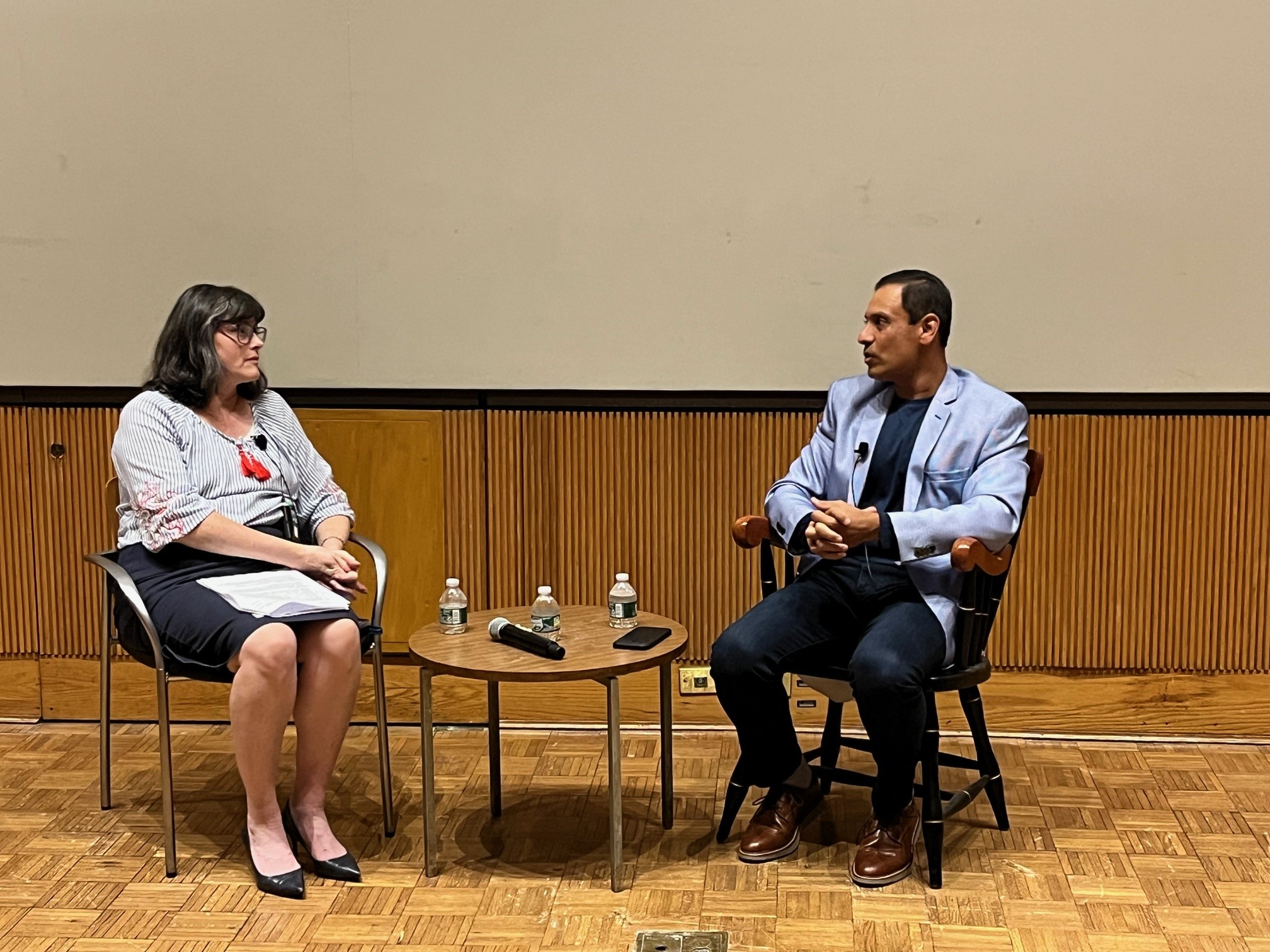
When asked to recommend a research area to focus on, Dr. Vishwas Seshadri, chief executive officer of Abeona Therapeutics, Inc., said he would choose gene therapy, cell therapy or immunotherapy because they could make a lasting impact on patients after just one treatment. That’s transformative, he said to graduate students and early-career researchers in Uris Auditorium.
Dr. Seshadri was the guest speaker kicking off the Fall 2025 Accelerating BioVenture Innovation (ABI) course on Sept. 2. In a wide-ranging interview with BioVenture eLab Director Loren Busby, Dr. Seshadri, a scientist turned biotech executive, spoke about R&D, manufacturing, leadership, regulatory affairs and market access.
“It was an excellent conversation to prepare participants for the work they will be doing in class.” Busby said.
Dr. Seshadri has always been fascinated by what science could contribute to the field of medicine and by genetic medicine. He pursued his doctorate and post-doctoral research in microbiology, immunology and molecular biology at the University of Arizona focused on epigenetic controls of gene expression, which have helped enhance understanding of molecular mechanisms behind several diseases like cancer, before he moved on to industry.
He credits his first job at Dr. Reddy's Laboratories, a generic drug manufacturer, with teaching him the skills to manage the variability inherent in manufacturing biologics and producing complex drugs with rigorous upstream quality specifications. This experience also sparked his interest in the strategic side of business and brought him back to the United States from India.
With a combination of biotech background, industry experience and a Master of Business Administration in finance and health care from the Wharton School of the University of Pennsylvania, Dr. Seshadri was recruited by Celgene Corporation for numerous roles. There, Dr. Seshadri gained experience in business and financial planning, product development and performance analysis, global marketing, and regulatory submissions to the U.S. Food and Drug Administration and other health authorities.
Unbeknownst to him at the time, the company’s embrace of efficient, entrepreneurial and innovative approaches to transform medicine would prepare him to lead Abeona, a publicly held cell and gene therapy company headquartered in Cleveland, Ohio.
He faced a challenge soon after joining Abeona. Abeona was in a difficult financial state with about three to four months of cash runway. Dr. Seshadri had to choose which one of their two clinical stage therapeutic candidates to bring to the finish line. Eventually, he decided to push the autologous, gene-corrected cell therapy Zevaskyn™ through FDA approval because the endpoints were expected to take a shorter time to achieve, while licensing out the other program to another company to ensure that it reaches patients one day.
Zevaskyn™ is designed to treat wounds caused by recessive dystrophic epidermolysis bullosa (RDEB), a devastating, rare skin disease. A mutation in the patient’s COL7A1 gene causes the loss of tightness in the connection between the top and bottom layers of their skin. As a result, the patient’s skin forms blisters and wounds that cover large areas of their body. They must endure painful frequent redressing and will develop carcinomas or sepsis over time and die young.
To set up a clinical trial site for such a rare disease involves a multidisciplinary team, buy-ins from an academic medical institution and its faculty and staff, as well as lots of administrative work. Abeona has been negotiating reimbursement with private insurance companies ahead of launch, and many of them have already instituted favorable policies. Abeona is also negotiating with the Centers for Medicare and Medicaid Services.
Prior to FDA approval, rigorous payer research was conducted with the guidance of experienced consultants to determine a reasonable price for Zevaskyn™. One important factor Abeona had to consider was whether the negotiated price would be sustained throughout the treatment regimen to address all wounds. Dr. Seshadri thinks that is a huge responsibility because they want to continue to provide patients with this life-changing therapy in the long run.
Aside from recounting the lab to market process of Zevaskyn™ in details, Dr. Seshadri offered his candid view on the current state of biotech investment and operation. “I think the landscape is changing. The investment ecosystem, the capital ecosystem is also changing,” said Dr. Seshadri. “A great scientific idea in today's biotech environment is not sufficient to get you the right kind of valuation. You need to show the valuation from a commercial standpoint: how this drug is going to perform, what unmet need it’s going to serve and in what unique way it is going to serve that's not done by any other potential therapies that are either in the current landscape or emerging landscape.”
In other words, a biotech company has to possess a differentiating technology, a viable model to become a profit generating entity and the ability to execute to impress investors with commercial potential.
During the ABI talk, Dr. Seshadri also shared three pieces of advice that former Celgene CEO Bob Hugin imparted to summer interns: work in a company that faces tough challenges; learn something new every day and get a job in a small company early in your career. That breadth of hands-on experience at a smaller company allows scientists who are transitioning from academia to industry to grow rapidly. Additionally, learning how to form relationships and trust is important.
“Find mentors that can make your career. Everybody says that those are the relationships that take you through,” said Dr. Seshadri. “I'm here at Abeona because of that.”

